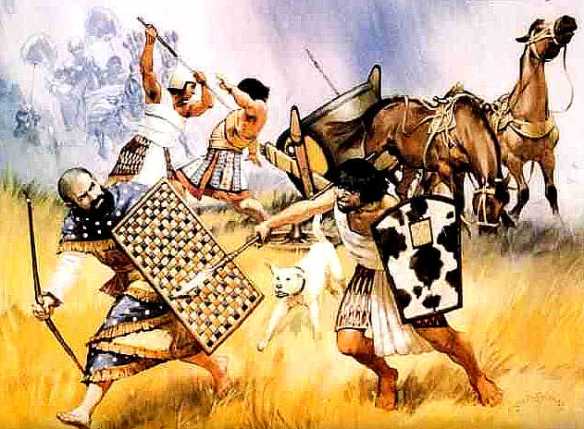Hyksos and Egyptians
An ancient population that conquered and dominated Egypt between the eighteenth and sixteenth centuries BCE. Power slipped from the pharaohs of Egypt in the late Middle Kingdom, during the Thirteenth Dynasty (1786-1633 bce), when they were conquered in a relatively easy victory by the Hikau-Khoswet people. The name Hikau-Khoswet originated from the Egyptian phrase meaning “rulers of foreign lands.” An Asiatic group primarily composed of Semites, the Hikau-Khoswet, of Hyksos, reigned over Egypt for well over 100 years, beginning from about 1750-1700 bce, and ending with the establishment of the New Kingdom in 1567 bce. The main catalysts that enabled the Hyksos to conquer the Nile delta so easily were the internal dissent among the Egyptians themselves, a counter revolt of the nobility, and a weakening of the power of the pharaohs.
The Hyksos were said to be well trained and well-armed, and were credited with introducing the horse and chariot to Egypt. The Egyptian forces of the time were exclusively infantry armed with copper weapons. Assuming the Hyksos invaded with cavalry and chariots, scale armor, bronze weapons, and composite bows, the Egyptians would have been completely outclassed. Whether the Hyksos entered Egypt in one major invasion or through a gradual buildup of population (both theories are proposed), it is almost unthinkable that the Egyptians could have given them much serious military opposition. Moreover, if the Hyksos’ forces included Arabs, then camel-borne troops would also have been used, which would have been a complete surprise to the defenders.
During the course of the Hyksos’ invasion, towns and cities were burned, temples were damaged, and the native population was subjected to severe hardships and cruelties. Once the Hyksos gained control, they imposed heavy taxes as well as a strong military dominance on their subjects. Surprisingly, the majority of Egyptians accepted this style of leadership with- out much resistance.
The origin of the Hyksos is the subject of much debate, although they were probably a Canaanite tribe from the east coast of the Mediterranean, possibly Palestine. The third-century Egyptian historian Manetho describes the dynasties of the Hyksos’ occupation as Phoenician (XV Dynasty) and Syrian (XVI Dynasty). Most authorities agree that Canaanite culture introduced the chariot into Egypt. The Hyksos could well have been aided in their invasion, at least indirectly, by the Nubians. The Nubians were in conflict with Upper Egypt in the area of modern Sudan and through the region east of the Nile. It has been speculated that the Hyksos were to some extent allied with them. This may explain why the Hyksos remained concentrated in Lower Egypt, perhaps as the result of an agreement with the Nubians to divide the spoils of their conquests.
The Hyksos were not entirely preoccupied with military goals. According to William Hayes, “The Hyksos kings of the Fifteenth Dynasty brought about the construction of temples, production of statues, reliefs, scarabs, and other works of art and craftsmanship” (Hayes, 1959), some of which are regarded as the best examples of Egyptian literary and technical works of that time. Practical and useful inventions such as the well sweep, the vertical loom, and the composite bow were Hyksos legacies. Egypt until this time was behind other Mediterranean civilizations in technological advancements. Thanks to the Hyksos, they were now able to learn of bronze working, the potter’s wheel, and the use of arsenic copper. The Hyksos also introduced hump-backed cattle and fruit crops, as well as new planting and harvesting skills. Evidence suggests that the Hyksos encouraged exercise through dance and expression through new musical instruments.
On the whole, the Hyksos seem to have been a powerful and influential people, but there were only a few rulers able to take credit for the advances. One of the six Hyksos rulers was Prince Salatis, a name that has been interpreted to mean “Sultan.” During his rise to power, he banned the contemporary Egyptian rulers from the capital city of Memphis and extended his rule over most of Middle Egypt, eventually taking over Upper Egypt and Nubia as well. In the meantime, Hyksos rulers had moved the capital to Avaris, the location of which remains a mystery. Although the Hyksos invaders were eventually overthrown by the Egyptians in the late 1560s bce, they left behind the tools and knowledge that helped build Egypt’s future empire.
References: Baines, J., and J. Malek, Atlas of Ancient Egypt (New York: Facts on File, Inc., 1980); Hayes, W., The Scepter of Egypt (Cambridge: Harvard University Press, 1959); Van Seeters, J., The Hyksos (New Haven: Yale University Press, 1966).
